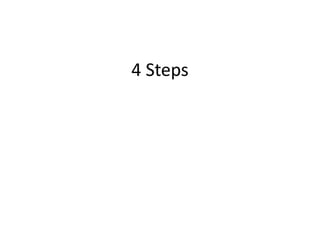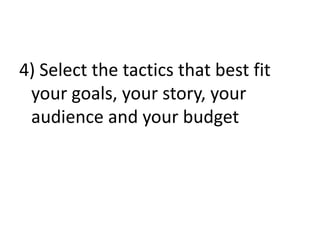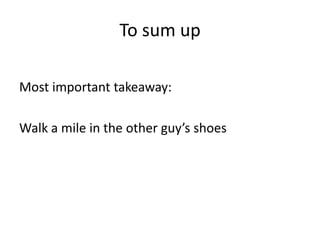PR 101 - David Green
- 1. PR 101David GreenDavid Green Communications LLCwww.dgreencommunications.com
- 4. You can tell me this glass is half-empty or half-full and I will believe you
- 5. But don’t try to tell me that this glass runneth over
- 6. When you do that, the results can be quite powerful
- 7. So how can you make PR work for your company or non-profit?
- 8. 4 Steps
- 10. 2) Identify the stories you should be telling
- 11. 3) Identify the audience for your message
- 12. 4) Select the tactics that best fit your goals, your story, your audience and your budget
- 13. PR tacticsEventsCommunity involvement (sponsorships, volunteering)Public speakingInformational content on your websiteMedia placementSocial media
- 14. The media
- 15. Is traditional media dead?
- 16. Tips for dealing with old and new mediaKnow who you are trying to reachFind a media outlet that is trying to reach the same audienceMake a match
- 17. More tips for dealing with the old and new media Put together a media listDetermine the best way to contactBe persistent
- 18. More tips for dealing with old and new media4) Monitor coverage5) Promote coverage
- 19. Briefly, other things to considerBecome a publisher – start a blogPut informational content on your websiteWrite articles under your byline for trade publicationsPlan ahead for what to do when things go south
- 20. To sum up Most important takeaway:Walk a mile in the other guy’s shoes
Editor's Notes
- Thanks. As Tim mentioned, I have my own PR firm called David Green Communications in Nashville. We serve a wide range of clients in a variety of industries – from financial services to healthcare, hospitality, accounting and non-profits. In my previous life, I was managing editor of The Tennessean, the daily newspaper in Nashville. I was in charge of all the journalism for the print product and website – ran a staff of a couple hundred journalists, decided what went on the front page each day and had overall responsibility for what we published. I have also been an editor at the Lexington Herald-Leader in Kentucky and for The Associated Press in New York.Tim asked me to give a presentation on the basics of Public Relations. And before I start, I should say that I want this presentation to be interactive, so please feel free to interrupt with questions.Different people mean different things when they talk about public relations, but I thought I would try to sum up what can go right in public relations and what can go very wrong in one word (NEXT SLIDE)
- If I showed you this logo three years ago, what words would have come to mind? (Ask audience)What words come to mind today (ask audience)Why the change in perception? (Ask audience)Two basic things went wrong. Most important – more important than any communications strategy – was that the underlying reality had problems. The chairman of Toyota himself acknowledged that the company got off track from its quality mission. And then there was the way the story was told:
- There has been lots of negative coverage about the problems with Toyota’s quality – but what made it worse – much worse – were stories such as this one from The New York Times (read headline) that suggested that Toyota covered up its problems. (Read from text)
- I said at the beginning that different people mean different things when they talk about public relations. So in light of what we just said about Toyota, how can we define what public relations means when it is done well?I would say this – It is about telling the story of your organization in a way that generates favorable perceptions from the public, but doing it in an honest way. And generally public relations excludes paid messages, such as advertising.
- People are getting more media savvy by the day. They are bombarded with messages and have finely tuned baloney detectors.So the best starting point for a good public relations campaign is making sure that the underlying reality is good. (And if it’s not, be honest about it.) The next step is to make sure that you tell the story well.
- Pepsi decided to cancel its advertising budget on the Super Bowl and route the money to a social media campaign in which it is donating millions of dollars to charitable projects voted on by the public. Pepsi got tons of positive press and attention.
- What’s the mission of your company or non-profit? What are the goals for the year?Public relations programs should mesh with your overall strategy.If you are an automobile parts manufacturer, and it is important to demonstrate that you care about the environment, you might want to think about donating to organizations tied to sustainability. You might also be looking for story ideas to suggest to the news media that connect your company to sustainability.
- Now is the time to get down to specifics. You’re an auto parts manufacturer and you know you want to highlight sustainability … but how? With specifics. An announcement that ABC Auto Parts is now in favor of the environment is unlikely to get much attention. An announcement that ABC Auto Parts has reduced plastic waste by 50 percent and is donating part of the money it is saving to buy parkland probably would.To be effective in identifying stories, you need to know what’s going on in your organization and be viewing it with a different eye than many people would. Sometimes your company or non-profit is doing something worth telling the world about, but doesn’t recognize it because it is so familiar inside the organization that it seems routine.
- If you are involved in marketing, you’ll notice that the steps I am outlining here are very similar to putting together a marketing plan – and this one certainly is. You need to know who you are trying to reach and how they like to receive information. Are they newspaper readers, TV watchers, Facebook users? Do they go to trade shows? Or perhaps they like to attend educational events sponsored by a certain Bowling Green marketing agency?
- There are lots of ways to approach PR: Events, charitable giving, community involvement, public speaking, informational content on your website, media placement, social media.In a few minutes, I am going provide some extra attention to media placement and social media, since those are areas where I specialize. But for now, let’s look at the whole landscape. And I should add at this point that some organizations may consider some of these tactics part of marketing – it’s hard to draw the line sometimes.
- Let’s take ABC auto parts. As I mentioned, they know a lot of people care about the environment and that cars are a big source of pollution. They want to show that they are doing their part to improve sustainability. They’ve been able to reduce waste plastic by 50 percent and plan to donate some of the savings for parkland. What do you think their PR plan might look like? (Promote discussion) Who might be their audiences? How can they reach those audiences?
- As I mentioned earlier, I am go to spend some extra time today talking about the media. I’ve had the good fortune to be on both sides of the table – previously as a news executive and now as a PR person. When I was managing editor of The Tennessean I used to have people tell me all the time that they didn’t understand why the newspaper printed what it did. Now as a PR person, I can explain it to them since I used to be the one who made the decisions.Of course the definition of “the media” has changed dramatically over the course of my career. With the advent of blogs, Facebook and YouTube, anyone can be a publisher.That’s made it both easier and harder to do PR. On the one hand, you’re not as dependent on the decisions of a few people at the local newspaper or TV station in getting your story out. On the other hand, it can be a bit bewildering to know which of the many available outlets to use.Part of the skill is understanding the technology. That’s a whole subject in itself and not one I am going to get deeply into today. Instead, I am going to give you some tips for getting your story published or broadcast – whether you’re submitting it to someone else or you are doing it yourself.
- One of the most embarrassing mistakes you can make as a newspaper journalist is to publish an obituary on someone who is still kicking.Now that has happened to newspapers and other traditional media themselves.There is no doubt that the audiences for traditional media have declined and will continue to do so. On the other hand, they still have a lot of life in them.I can tell you that in the Nashville market, The Tennessean still by far reaches more people every day than any local website. I would guess the same would hold true for the News in Bowling Green.And maybe a bit surprisingly, many of the tips I have for you on dealing with traditional media apply to digital media as well.In fact, traditional and digital media are far more interconnected than many people realize. First off, virtually all traditional media have their own websites and are using social media.What’s more, many bloggers draw on traditional media for their source material. And many journalists working for traditional outlets find story ideas and information on social media and websites.
- One of the most important things to remember when trying to pitch a story – be it to traditional media or a blogger – is that the outlet has its own mission to accomplish. That mission is to attract and retain readers or viewers.They generally don’t see their job as publishing or broadcasting your press release as is – although sometimes they may do that. They are using your press release as source material to find a story that will most interest their audience.So I would like to do a small exercise. I am going to give you a press release issued by ABC Auto Parts and I want you to take a few minutes to rewrite it as if you were a reporter for a local newspaper.If the press release left you with any unanswered questions, please jot those down as well.You won’t have to turn in your press release, I am just going to ask some of you what you wrote.
- As I mentioned earlier, you want to start by identifying those media outlets – be they blogs, newspapers, TV stations, whatever – that reach the audience you want to target.Put together a media list. This should include contact information for the specific person or people at the media outlet who deal with the topic you are publicizing.How can you find that out? If you have a lot of money, you can use one of the commercial services that track journalists and bloggers.If not, you can just go to the outlet itself and look for coverage on the topic you are interested in and see who has been doing it. Or you can try calling the outlet and asking them who covers the topic. So what’s the best way to contact someone? It’s just like anything else. If you know someone at the website, newspaper, TV station, get in touch with them and ask to be directed. If you have no contacts, try emailing the reporter or blogger. If you don’t get a response, try following with a phone call.Be forewarned that most journalists are extremely busy and you may not be able to reach them by phone and bloggers you almost certainly won’t be able call.But be persistent. Things fall between the cracks at news organizations, must like everywhere else.
- Once you’ve made your pitches, start monitoring the outlets involved to see what – if anything – they publish or broadcast.If they do use something, make the most of it. Republish the material on your website – you can either link to it, in which case no permission is required – or republish it in full. Republication generally requires the permission of the outlet involved.Use your email list and social media to promote the item. Link to it on your blog and newsletter. Tweet about it. Post about it on Facebook and LinkedIn. If it’s really big, you might want to send a special email to your list.




















